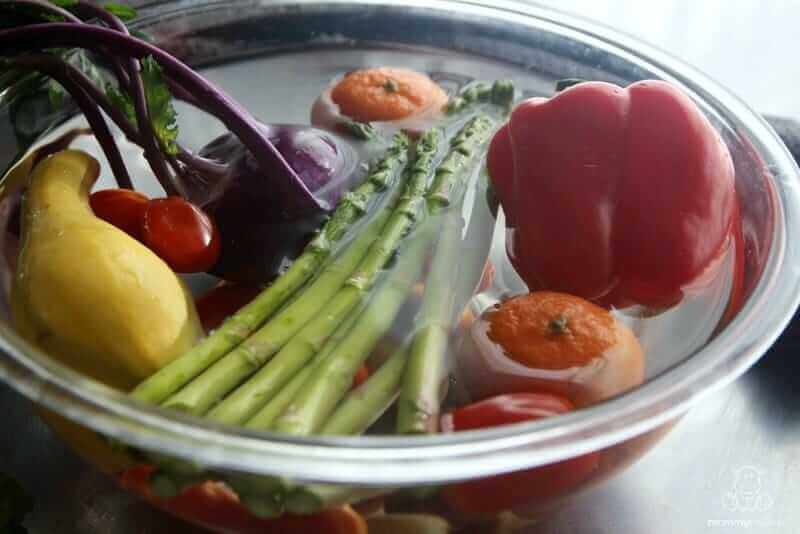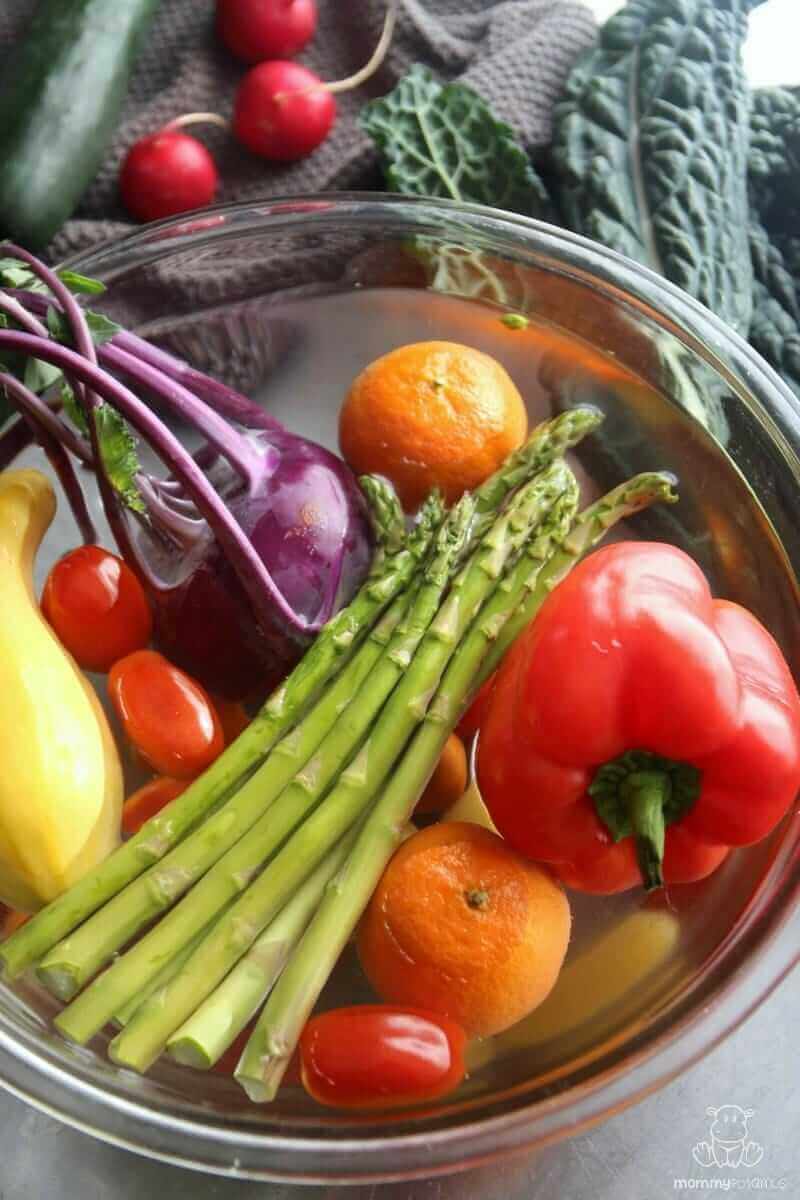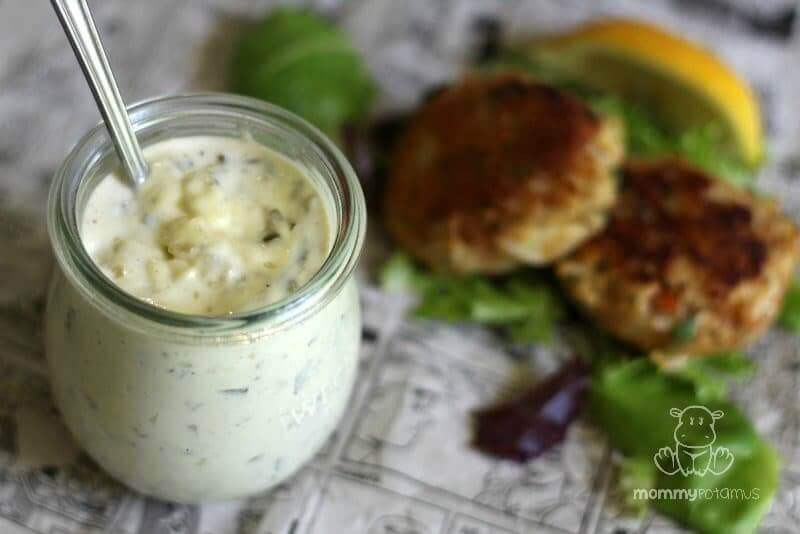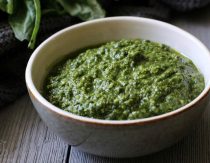
Despite what lawmakers say, pizza sauce is not a vegetable. For starters, tomatoes are fruits.:)
Now, there have definitely been times when I’ve put egg drop soup on the table with pickles (also a fruit!) because it’s all I could pull together, but I try to include veggies as much as possible – creamy kale salad with lemon, spaghetti squash alfredo, Mexican-style chopped salad, coleslaw, sauteed cactus buds. Okay, not that last one.
The point is, we’re big fans of fresh produce over here. But pesticide residue? Not so much. Although we avoid the dirty dozen and buy organic whenever possible, there is still the possibility of some residue due to pesticide drift from other fields.
That’s why over the years I’ve tried to keep tabs on the best research-backed ways to clean produce. Here are the top two natural ingredients you will find mentioned in DIY Veggie Wash recipes, which have both been found to work as well – or even better – than the veggies washes sold in stores: (NPR)
Vinegar
One study done by Cook’s Illustrated found that a vinegar solution (one part vinegar, three parts water) outperformed plain water, antibacterial soap, and manual scrubbing in cleaning ability. For example, vinegar removed 98 percent of bacteria compared with just 85 percent removed by rinsing with water and using a vegetable scrubber. (NPR)
It’s unclear how effectively diluted vinegar removes pesticide residue, but one study did find that soaking potatoes in 5% acetic acid (pure vinegar) for 10 minutes removed up to 100% of certain pesticides. (Bajwa et. al.) That’s a lot of vinegar to go through on a weekly basis, though, which brings me to our next ingredient . . .
Baking Soda
According to researchers at the University of Massachusetts, soaking apples in water mixed with baking soda for 12-15 minutes almost completely removed two common pesticides from the surface of the apples. (He et. al.) Another study using cucumbers found similar results. (Liang et. al.) This method requires a only a teaspoon or two of baking per batch, which is pretty cost effective.
So, can I combine the two?
Unfortunately, no. Vinegar is an acid while baking soda is a base, so if you mix the two together they will neutralize each other.
In the next section I’ll share several ways I use them in my kitchen. Whichever one you go with, keep in mind that many fruits and vegetables are now covered in wax, which can seal pesticide residue and bacteria underneath the surface. In order to really clean produce, combine the cleaning power of the recipes below with a good scrubbing using a produce brush.

3 DIY Fruit And Vegetable Wash Recipes (Soak Method)
Recipe #1 With Baking Soda (Soak Method) – Add 2 teaspoon to 4 cups of water and soak produce for 2-15 minutes. The longer the veggies and fruit soak, the more pesticide residue is removed. Scrub with a produce brush for extra cleaning power if you have one, then rinse.
Recipe #2 With Vinegar (Soak Method) – The studies done on vinegar have used different ratios, usually 1:10 (one part vinegar to 10 parts water) or 1:3 (one part vinegar to three parts water). How much you use is up to you, but because straight vinegar has also been shown to remove certain pesticides (and probably others that have not been tested), I go with 1:3. The study using 100% vinegar only soaked for 10 minutes to achieve results, so I use a 1:3 ratio and soak for 20-30 minutes or longer. Scrub with a produce brush for extra cleaning power if you have one, then rinse.
Recipe #3 With Vinegar (Spray Method) – My go-to for a veggie spray is a 50/50 mixture of vinegar and water. Just spray onto produce and allow to sit for about 5 minutes, then scrub and rinse thoroughly.
Want a FREE ebook of non-toxic cleaning recipes that WORK?
I’ve created a free ebook for you as a gift for signing up for my newsletter. 7 Non-Toxic Cleaning Recipes That Really Work covers seven recipes that you can make in just a few minutes each for squeaky clean windows, sparkling dinnerware, lemon-fresh countertops, and more. Subscribe to my newsletter below and you’ll be redirected to a download page for immediate access to this PDF ebook.





I wash my veg with Sal suds
Does it matter if you use white or brown vinegar?
Any vinegar that contains 5% acetic acid (which to my knowledge is most or all vinegars) will work.
Thanks you! I’ve only been using water and a brush, but plan to start with the spray method. thanks!
With the vinegar soak, have you noticed any vinegar soaking through into the produce and effecting the taste?
I do a vinegar soak and do not notice that the fruit or vegetables have any kind of vinegary taste. I feel as though they taste better once properly cleaned!
Hey! I live in a country where the tap water isn’t safe to drink. In a previous location, coworkers soaked their veggies in a bleach and water solution, but I worry about the health consequences of that. Lately, I’ve been trying to use the vinegar and water method, and it’s great to know there’s evidence to support that. Is there any evidence that baking soda does the same? Hypothetically, this could be an issue in the States, too, if produce hasn’t been carefully handled along its supply chain.
Hello! What brand of vinegar do you use? I use white vinegar in my laundry rinse cycle, to spray down our counters before we process our meat from our farm, etc. I usually buy it in big jugs and from what I’m reading the one I’ve been using is not Non GMO. I seem to use it for lots of things and I do a ton of laundry because we have a 20 acre farm, raise our own meat and we homeschool so my family always has a ton of laundry. So do you have a brand you recommend? We don’t drink or use in any food, I only clean with it and use it on our laundry but I hate to keep buying the GMO product and supporting the company but I also don’t want to spend a fortune. From what I can tell Non GMO vinegar is expensive. Also, do you have a brand for baking soda and washing soda you recommend? Thanks!
Heinz All Natural Distilled White Vinegar. Made only from corn and cristal-clear water. That’s the only one I use.
Is the corn NON-GMO?
Unless your white vinegar says it is made from GRAIN, it is made from petroleum! Heinz is made from PETROLEUM, NOT GRAIN. I’d rather use a GMO product than petroleum in/on my food. Organic is spendy, but I have found some. I use white vinegar made from “sun ripened grain”, the Essential Everyday brand. The organic is Spectrum brand.
I’ve never heard this!! Is this true, that Vinegar is made from petroleum? I’d really appreciate if the blogger, Heather, could answer this because if you are encouraging people to spray their food and soak it in petroleum, that is something to answer! Thanks!!
Heinz is made from corn and apples, not petroleum. https://www.businesswire.com/news/home/20090505006031/en/Vinegar-Petroleum-Heinz%C2%AE-Offers-Naturally-Choice
However, the corn is likely GMO. Because vinegar brands vary so much by store I can’t make a recommendation that will apply across the board, so I encourage you to reach out the the brands that are sold in your area and ask about sourcing.
Synthetic alcohol is used for making vinegar?
Yes, though any alcohol can be used to make vinegar, synthetic alcohol is often used for commercial vinegar production.
The majority of commercially produced vinegar in the United States uses alcohol derived from barley, corn, fruit, wine, natural gas or petroleum. Yes, you read those last 2 ingredients correctly.
https://www.happy-mothering.com/what-is-vinegar-made-of/
As I stated before, the distillation of fermented molasses into a relatively clear alcohol called “low wine” is why Americans call spirit vinegar “distilled vinegar”. However, nowadays white distilled vinegar is not distilled in any part of its process. What happened in the post World War II period was the introduction of cheap ethanol made directly from ethylene that could be extracted from natural gas. This process, known as the Wacker Process, gave the vinegar industry ethanol cheaper than they could get from molasses and without the expensive distillation equipment that one would need. From this point on, white distilled vinegar, at least in the USA, would be made directly from ethanol.
However, the ethanol can come from any source as long as it is not tainted and is fermented naturally to white distilled vinegar. As manufacturers we also are not mandated to disclose the source of the ethanol.
continued:
Guaranteeing a vinegar isn’t coming from corn ethanol is hard. The good news is that corn ethanol is relatively expensive for a feedstock so most use imported sugar beet alcohol from France or sugar cane alcohol from Brazil. Corn vinegar (as vinegar from corn syrup or corn alcohol was once called) has declined in popularity in the US. Heinz is probably the biggest risk for corn based vinegar but Fleischmann’s is now owned by a corn ethanol company so they may use it.
In addition, private label vinegars at the store can come from multiple companies and these could use different sources of ethanol.
Distilled corn alcohol probably has most allergens taken out in distillation and vinegar fermentation so I don’t think the risk is large but if you want to use white distilled vinegar Four Monks from Mizkan most likely doesn’t have corn ethanol. It can be hard to find though I think it is on Amazon and some other sites.
Finding a distilled white vinegar that is guaranteed to not use corn is hard, since ultimate ingredients aren’t required by disclosure guidelines. My first question is are you sure it is only GMO corn and not corn in general? If you are sure (and have confirmed by tests) that it is only GMO corn, there are organic white distilled vinegars sold by Spectrum Naturals and Fleischmann’s. They are on Amazon. However, I know for a fact that they use non-GMO corn as a source for the distilled alcohol to make vinegar.
continued:
Many brands source their ethanol from different places. In the past few years some of the larger private label manufacturers have received a lot of ethanol from Europe or Brazil which I am unsure of the regulations regarding GMO and Glyphosate. Others use domestic corn ethanol which is probably GMO.
To be frank, I don’t know how much Glyphosate remains after distillation. I would stay with organic if you are concerned.
https://supremevinegar.com/2016/08/22/white-distilled-vinegar-ingredients-explained/
Grains used for making white vinegar are usually corn and sugar beets, which are highly genetically modified with Monsantos Glyphosate. Many companies are also using imported ethanol, and are not required to list what grain nor where it is from.
Heinz does say on their website that their white vinegar is made from grain, but it is NOT listed on their product.
Wow, Carol, that is a plethora of information, thank you! I think I’ll look into organic vinegar. It’s basically the only thing I use to clean my house, and anything really, other than dr. brawners. Crazy to think I’ve been coating all surfaces of my life with GMO corn. Grrrr.
Great idea thanks for sharing it!
I’ve heard that grapefruit seed and/or lemon EO in water or vinegar is good to clean them since they have antimicrobial properties. I wonder if that would only be effective with E koli rather than pesticide or wax residue. I also wonder if that would leave a residue on the produce that would affect the taste. Do you know or has anyone tried it?
Love this article. Do you use one of these methods for berries too?
I have used both soaking methods, but I don’t leave them in as long because they have thin skins and I don’t want them to absorb any flavor from the vinegar/baking soda.
Do you wash them when you get home or just before using them?
(From Patricia on July 5, 2019)
It depends on the veggie/fruit and my schedule. For items like cucumbers, bell peppers, etc., I usually wash in advance, and for others that are more prone to spoilage I wash right before using them.
Do you wash all of your produce after shopping before putting it away or do you wait and wash it just before cooking?
Great questions. It’s a bummer how some questions never get answered! It would be nice to see bloggers pay their readers the respect of answering at least the really good questions. I guess unless they don’t know the answer. Better nothing than fake news I suppose.
I completely agree. When I see bloggers not answer questions a lot, such as Wellness Mama and this one, I lose a lot of respect and stop reading their blog. The only reason I’m reading this that it just appeared in my inbox with a comment…
Hi Jenny, if you look at the comment thread just above this one you’ll see that I answered this question just a few days ago. It’s true that sometimes I don’t answer questions. As much as I’d like to be able to respond to every single one, I’m currently responding to 700+ active threads and sometimes I just can’t get to them all.
Just to give one example of why, over the past 10 days I packed up my entire home and moved to a new home. I’m still surrounded by boxes but just logged on to try to answer as many as I can before starting dinner. Ideally I’d go back to the ones I don’t get to when my house is unpacked, but in reality more questions will roll in and I’ll have my hands full answering those.
There was a time when I stayed up late trying to get to every question every day, but in doing so I wasn’t staying true to one of the wellness practices I believe has the most impact – making time for rest and recovery. I hope that this insight allows you to see my responses (or sometimes lack thereof) in a different light. If not, I hope you find a resource that works for you.
In addition to the Vinegar methods, we have used diluted 35% Food Grade Hydogen Peroxide for fruit and vegetable soaks for years. Note: PLEASE DO NOT combine vinegar and Hydrogen Peroxide. Also when using 35% HP, there is a learning curve; it will sting your skin at this strength so be careful to wear gloves.
I have various combinations of dilutions for different things, but the one I use for soaking is undiluted HP poured into a spray bottle. When I bring the veggies/fruits home from shopping, I place them in a large bowl and as I fill it with water (pure well water), I spray the HP onto the veggies, stir them around and leave them to soak for 15 minutes or more.
The only exception is the bananas, avocados and cucumbers which I hand scrub with dish soap and then spray with vinegar or HP, letting them sit for a short time.
I spray sinks, counter tops, and dish rags I’m using with it too!
Where do you purchase the 35% HP ?
I’ve used peroxide and table salt for cleaning fruit and vegetables. Is this effective?
I was also curious about a peroxide method. Is there one that uses food grade 3%?
I’m hearing about a lot of good uses for the apple cider vinegar.